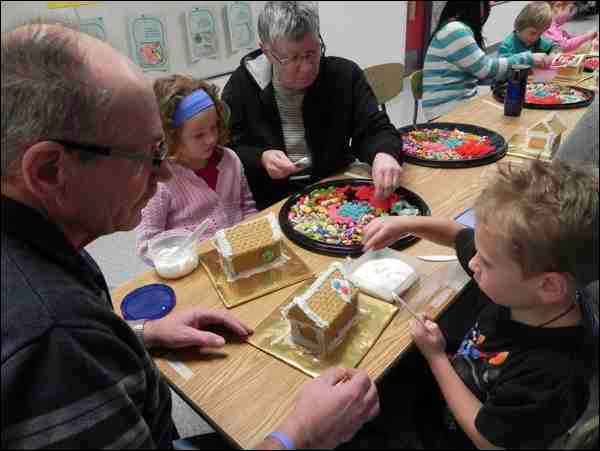There is a long history of gingerbread houses.
They have been shaped into Christmas tree ornaments since at least the Victorian era. They became popular after the Brothers Grimm published their book, Hansel and Gretel. In the 17th century, only professional gingerbread makers were allowed to bake the stuff year-round. That restriction was later lifted during Christmas and Easter, which may explain the connection between Christmas and gingerbread.
Folks may remember setting up the kitchen table on a Sunday afternoon to create their own gingerbread house to be eaten during the Christmas holidays. Mom had the walls and roof prebaked so the decorating party focused on the artistry.
Unity Public School kindergarten teacher Therese Robertson has been offering this age-old tradition to her students for 25 years. Her love of this project began when she was in Cut Knife and Anita Veikle taught her how to make gingerbread forms as well as the icing to help with the decorating process. She has not stopped making them since.
She used to make real gingerbread but in later years has been using graham wafers because of the large classes of students, in addition to the time needed to bake and assemble the real stuff. But this doesn't diminish the excitement in the children's eyes as they set to the exciting task ahead of them.
Robertson used to have parents, grandparents and helpers come to her house to prebake and assemble the forms for the houses. Now she assembles the houses for her classroom herself. As well, she makes even, neat little containers of icing for each student to work with. Her prep work doesn't stop there. She sets out shopping, looking for the perfect red and green, long and short, round and square candies to help the gingerbread creation evolve into the perfectly constructed home. Who says a teacher works from 8 - 3:30?
The morning of the project, Robertson and an educational assistant make up large candy trays to set at each work table so children have a big assortment of choices for their shingles, doors and windows. Parents and grandparents are invited to the classroom to help each child assemble his or her creation. Each child works diligently, putting the finishing touches on the gingerbread house as they know they get to take them home at Christmas to share with the family.
They also construct three extra houses to raffle off for the bargain price of three tickets for 25 cents. The proceeds from this yearly raffle help purchase supplies for the classroom or the school. In past years, when the Festival of Trees was held at the school, the tiny, handmade houses used to make several hundred dollars for purchases for the school.
This project isn't taken on each year just because it's yummy. It is a project that helps foster learning in creativity, patterning, colours, shapes, counting, three- dimensional building and much more. The wide eyes of children trying not to be tempted to pop a candy or two in their mouths while creating is priceless. But they each show kindness and constraint in the building and learning process.
Some students spend much time counting and aligning their candy pieces so the shingles look even. Some students love the abstract look and create by colour and shape. There are even students who use their creativity to landscape around their gingerbread house. Nonetheless, not one of them realizes or cares that they are learning as they are having loads of fun in the construction process.
Robertson, in her patient, kind voice said she always enjoys this annual project. In all the years she has done this she has only had one disaster. One year she created just a few larger gingerbread houses for the kids to decorate and the roof caved in on one, bringing out a few tears along with some disappointment amongst the creators.
Some former students still have their houses as one of their favourite keepsake memories from their kindergarten days. Most students are anxious to get their precious homemade treat home to share with their family. And the winners of the raffle are always thrilled to have this handmade creation come to their house for the holidays.
In math terms, 25 years of creating gingerbread houses times an average of 20 students plus an extra three houses per year for the raffle equals approximately 575 gingerbread houses made in Therese Robertson's classrooms in the past two and a half decades. Hansel and Gretel would be ecstatic!




